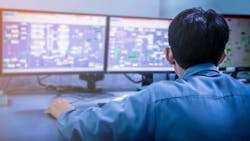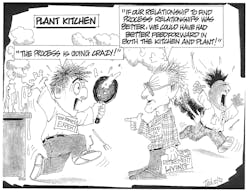GREG: We tend have a mindset of PID action to meet our process performance objectives. While we always need feedback control due to imperfect knowledge, the correction is inherently limited to being after the fact in terms of an error. Also, the enemy of deadtime is big time because the appearance of the error and the correction for the error is delayed. There may be many more opportunities to preemptively correct for a measured disturbance via feedforward control than we realize.
Measurements and studies often done to help operations and process engineers better understand what is happening in the process may open opportunities for feedforward control, which offers quick and inexpensive implementation that simply requires the configuring and parameterization of a feedforward controller. Matthew Howard, Pulp Mill Area Process Systems Manager for Sappi North America, gives two examples of fast and effective feedforward control for a paper mill that he presented at the 2022 TAPPI conference.
MATTHEW: In the first case, an SO2 scrubber sump is used for stack gas emissions leaving a boiler. It is necessary to pump a caustic solution into the sump of the scrubber. This caustic solution neutralizes the SO2 contained in the stack gas. A pH controller was installed in the DCS. It had pH as its controlled variable (CV) and an equal-percentage valve as its manipulated variable (MV). This pH feedback control loop was highly unstable, often oscillating by more than a full pH point above and below the setpoint.
This boiler can burn natural gas as well as woody biomass with a mixture of other fuels and secondary sludge from the waste treatment plant. It was found that the process dynamics of the pH response while burning different fuels was extremely different. The production engineer noted that a caustic flow meter was installed for accounting purposes years ago. It was also noted that an environmental department inlet SO2 analyzer was being used to measure the SO2 lb/hr entering the stack. With that information, a stoichiometric equation had been written in the mill historian for troubleshooting purposes to predict the gallons per minute (gpm) of caustic that should have been going into the sump. With these measurements installed and calculations verified, a great opportunity was being missed to improve the highly unstable pH feedback control loop.
A stoichiometric calculation of the dry caustic demand based on the inlet SO2 flow was implemented. This signal was sent to the output of the existing pH controller as an additive feedforward (FF) signal. This controller output was then sent as a set point to a new inner flow control loop for the caustic. This flow loop was configured to control caustic delivery on a dry basis instead of a wet basis to minimize pH disturbances caused by caustic quality variation.
The implemented scheme reduced the pH variation by about 90% across all boiler fuels. In this case, there was no Lead/Lag compensation because the effect of the disturbance variable on pH arrived after the effect of the feedforward variable on pH. However, the greater delay in the disturbance path than the feedforward correction path via pH controller output was not so late to cause a problem. The feedback tuning of the pH controller was tuned with a near integrator model with a relatively slow time constant. This allowed the feedforward correction to take place as the feedback correction was just beginning.
In the second case, the concentrators are the last stage of black liquor (BL) preparation for the recovery boiler. There was a history of poor solids control effecting the recovery boiler operation. This was due to operator manual and automatic control of the BL and steam feeds to the concentrators. The operators had a rule of thumb: “10 kpph of BL and 1 kpph of steam.” It seemed okay at steady state, but the boiling point rise (BPR), a measurement that correlates to product % solids, often varied whenever the operators adjusted the concentrator throughput.
Why couldn’t the concentrators be controlled to a target % solids? A scheme for BPR control was found and modified. A BPR controller was built that would supervise the steam flow to the concentrators. BL flow would be used as an FF variable. Bump tests were conducted on the BL flow and the steam flow separately. The dynamics of the BPR response were analyzed. The BPR response was much faster when the steam was changed compared to a change in BL flow. Also, the BL flow measurement is taken much further upstream. Thus, a dead time plus first order lead lag compensator was installed on the FF signal.
The BPR variation was reduced dramatically after the implementation in this scheme. Stabilizing the BPR of the product liquor leaving concentrator A had many benefits, including more stable fuel quality to the recovery boiler and more stable vapor flow to the rest of the evaporator train. This stabilization of the process led to further operational improvements.
GREG: What is your summary and perspective to help motivate automation engineers to do more than replicating feedback control?
MATTHEW: I have found in the mill that there are often transmitters installed for reasons such as accounting or process monitoring that could be further used for more advanced and robust control schemes. This is especially true around heat exchangers installed for energy reduction projects. When attempting to optimize a process, the plant engineer should not be afraid to look for temperature and flow transmitters that are already installed. The necessary instruments and valves may be found, already calibrated, and maintained. The above projects required no additional capital. It is not possible to implement effective feedforward controls without first being able to implement effective feedback controls. Dynamic modeling is a must for optimization. Remember, complicated schemes are not the goal. Controls that work all the time is the goal.
GREG: For much more on feedforward control, see the Mentor Q&A post started by Matthew “What are some ways to improve and prioritize feedforward and fast feedback control?” and the Control Talk column with Peter Morgan “A straightforward explanation of feedforward.”
Here is some guidance on how to make sure the feedforward does not do more harm than good.
First let’s consider the situations where the FF arrives way too soon creating inverse response or way too late creating a second disturbance. You can prevent it from arriving too soon by simply inserting a deadtime in series with the lead-lag in the dynamic compensation of the FF. Since there is no compensation for too much deadtime like there is with a lead for a lag in the FF, the best thing you can do is, if possible, start the FF before a setpoint is changed that creates the disturbance. In other words when the culprit setpoint change is requested, the FF starts and the actual culprit setpoint change is delayed so that FF is not too late.
Second, let’s see what we can do if an unmeasured disturbance is driving the PV in the same direction that the FF would do in its response to the measured disturbance. We can compute the current rate of change of the PV and the rate of change of the PV requested by the FF. The feedforward gain is multiplied by the fraction that is the expected PV rate of change from FF minus the current PV rate of change divided by the expected PV rate of change from FF. A Future-Value block can be used to quickly compute with good signal to noise ratio, the current rate of change observed and the expected PV rate of change from FF by a dynamic model of FF effect on PV developed from tests for dynamic compensation of the FF.Top 10 signs feedforward is too little or too late
10. Accounting says the plant is messed up
9. Trend chart scales all need to be increased
8. Operators are so busy they don’t have time to eat doughnuts
7. Any thoughts of going home are gone
6. The number of alarms is alarming
5. Process engineers are yelling at control engineers
4. Control engineers start thinking about early retirement
3. Tempers are boiling
2. Food is burning
1. Plant manager is calling
About the Author
Greg McMillan
Columnist
Greg K. McMillan captures the wisdom of talented leaders in process control and adds his perspective based on more than 50 years of experience, cartoons by Ted Williams and Top 10 lists.

Leaders relevant to this article:


